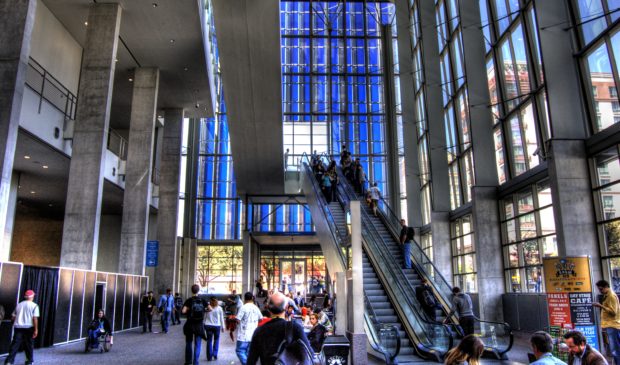Convention center fate looms as Tourism Commission scrutinizes Visit Austin budgets
Friday, October 12, 2018 by
Chad Swiatecki The most recent meeting of the city’s still-new Tourism Commission followed what could become a regular dynamic for the group: detailed “in the weeds” parsing of budgets and policies related to Austin’s tourism industry, with the proposed expansion of the Austin Convention Center looming over everything.
Monday’s meeting bore that out during an hour-plus analysis of the $15 million marketing budget for Visit Austin – formerly known as the Austin Convention and Visitors Bureau – that veered into debate on the city’s expenditures to market creative communities, how the convention center markets itself to large meetings and conventions, and what to expect from the recent plateauing of the city’s Hotel Occupancy Tax.
The debate exists between a cohort of commission members who are critical of the possible $600 million expansion of the convention center and another group of appointed members who are employed or well-versed in the travel and tourism industry and argue Austin is starting to fall behind in attracting both conventions and leisure travelers to fill the 13,000 hotel rooms downtown.
During a presentation from Visit Austin CEO Tom Noonan, Commissioner John Riedie began picking apart the agency’s expenditures including $297,000 for client development and $351,000 related to sales and recruitment at trade shows, where much of the meeting and convention business is brokered.
Riedie, who was appointed by frequent convention center critic Leslie Pool, questioned why much of the Visit Austin marketing budget is directed at conventions, which by some estimates constitute around 2 percent of 27.4 million annual visitors to Austin.
“We have an excess of subsidies for the convention center and have shown that the convention center can transfer (funds) into Visit Austin, but can the convention center transfer even more in, and have that directed by Council to be spent on film and music marketing?” he said. “I’ve been looking at what other cities do with cultural tourism and television, and we don’t do any of it. My goal is to bring more money to music and film marketing, and potentially do with television for cultural tourism what Nashville and New Orleans and Philadelphia do.”
Much of the discussion in the commission’s meetings has involved the many distinct funds Visit Austin, the city and the convention center keep in their budgets related to tourism and the repayment of previous convention center improvements, largely because of the statutory requirements and spending limits related to different uses of the hotel tax. Those budgetary partitions have led to frustration for some commissioners asking how much of Visit Austin’s budget is used for leisure tourism marketing versus recruitment of convention business.
“Why are people coming here? What do they do? Break that down into categories,” Commissioner Bill Bunch said. “Then compare what we’re spending money on, and if there’s not alignment then maybe we need to reallocate our funds and target those areas that are underfunded that are actually bringing people here. We’re ripping off our music community by wasting money on something that’s bringing in 2 percent of our visitors and getting 75 percent of the money.”
Commissioner Ed Bailey said the focus on specific line items and spending categories was taking attention away from helping the commission get a full grasp of the multifaceted tourism industry and the role meetings and conventions play in the rapidly changing travel economy.
“We’re all trying to make decisions about what we need to operate for maximum ROI for the city, but we don’t all understand all the pieces that go into the work,” he said. “We’re like accountants burrowing (into the numbers) and not learning the business of what it takes to have a successful No. 1 city. … Why is (HOT revenue) flattening out? … Are we in a dog fight, and we need to know it, and do we need to be spending more money? And where should we be spending it?”
Photo by Joey Parsons made available through a Creative Commons license.
The Austin Monitor’s work is made possible by donations from the community. Though our reporting covers donors from time to time, we are careful to keep business and editorial efforts separate while maintaining transparency. A complete list of donors is available here, and our code of ethics is explained here.
You're a community leader
And we’re honored you look to us for serious, in-depth news. You know a strong community needs local and dedicated watchdog reporting. We’re here for you and that won’t change. Now will you take the powerful next step and support our nonprofit news organization?






